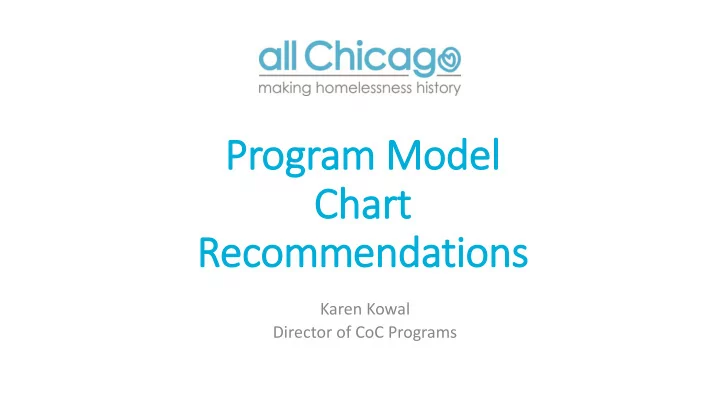

Progr ogram M Mod odel Ch Chart art Recom ommendations Karen Kowal Director of CoC Programs
What i is the Program Model Chart rt? • Foundation document for the homeless system • Identifies the program models that will assist in ending homelessness in our community • Gives the population, duration and essential elements for each program model • Sets performance expectations
Overview o ew of Changes 1. Simplicity. Move aspects that were standards to operate a program to Community Standards document. 2. Added Population Specialization as a category for some models 3. Each model includes an Outcome and corresponding Indicators that taken together will ensure achievement of the outcome a) Increased Income Potential = new indicator 4. Establish threshold indicators that set a minimum standard to achieve as well as challenge indicators that set a goal to work towards
Overview o ew of Changes 5. New Models: a) Shelter – moved Interim Housing, Emergency Shelter, Youth Interim Housing & Low Threshold Youth Overnight Shelter under Shelter b) Youth Rapid Re-housing (Y-RRH) c) Joint Component Transitional Housing – Rapid Re-housing (TH/RRH) 6. Youth Permanent Supportive Housing (Y-PSH) under Permanent Supportive Housing 7. Not all models were updated in these recommendations
Definiti tions Threshold Level or value to meet or exceed to exist; baseline Challenge Hard but attainable goal given current knowledge, capabilities and resources Retention Ability to retain housing over time Maintain income Ability to have income whether or not it increases, decreases or stays the same. Entire project is for one specific population and is required due to safety and Population service needs. Inherent in this focus is formal adoption or certification of national Specialization best practices for the special population. All staff receives specialized training.
Review o of Data ta 1. Data for each model type from 2018 and 2019 on each indicator. 2. Median = midpoint of the distribution of all project percentages 3. Average = total # participants meeting the indicator divided by the total # participants 4. Point where the most projects could achieve an indicator 5. Used the average or median percentage to determine the challenge
Shel elter er Population Population Specialization Time Frame Essential Elements • Individuals or families who are • Domestic Violence • Short Term: Days or Months • Low barrier to entry literally homeless • Youth • Diversion: Creative, problem- solving conversation • On-site basic needs: meals or kitchen access; showers and toiletries; storage • Connection to housing options • Case management (on-site or connection to) to ensure clients are linked to services and community resources that will help clients obtain or maintain housing, • e.g. building income, building independent living skills, developing education/career path, addressing a variety of physical, mental, emotional, and other needs 7
Shel elter er Indicator Current Threshold Challenge Outcome: Exits to more stable & permanent Connection to N/A 30% housing appropriate and stable Exits to permanent housing 30-90% 27% housing Maintain or increase income 85% 40% 52% (employment income or benefits) Increase income potential N/A TBD TBD Completed CES Assessments N/A 40% 60% 8
Youth R h Rapid R Re-housing ng ( (Y-RRH RRH) Population Time Frame Essential Elements • Individuals and families • Medium Term: Average 24 • Rental Subsidy who are literally homeless months • Coordination between between 18-24 years old at property manager / entry landlord • No disability required • Housing Location • Case Management • Pre-tenancy and tenancy • Referrals to services: education, income, benefits, legal aid, medical services (physical, mental, addiction, etc.), etc. • Emphasis on employment supports and benefits • Emphasis on connection to education, training, etc., and developing a career path • Progressive Engagement • Health Care Access • Medical Home 9
Youth R h Rapid R Re-housing ng (Y-RRH RRH) Outcome: Indicator RRH Threshold Challenge Maintain permanent Exits to Permanent Housing 70% 50% 60% housing Maintain or increase income (employment income or 66% 50% benefits) Increase income (employment 25% 25% income or benefits) Increase income potential TBD TBD TBD Maintain housing TBD TBD TBD 10
Joint T Transi sitional H Housi sing & P & Permanen ent H Housing – Rapid Re-housing ( g (TH/ H/RR RRH) Population Population Specialization Time Frame Essential Elements • Individuals and families who • Domestic Violence • Medium Term: Average 24 • Crisis Stabilization are literally homeless months • Youth • Rental Subsidy • No disability required • Coordination between property manager / landlord • Housing Location • Case Management • Pre-tenancy and tenancy • Referrals to services: education, income, benefits, legal aid, medical services (physical, mental, addiction, etc.), etc. • Emphasis on employment supports and benefits • Emphasis on connection to education, training, etc., and developing a career path • Progressive Engagement • Health Care Access • Medical Home 11
Joint T Transi sitional H Housi sing & P & Permanen ent Housing – Rapid R Re-housing ( g (TH/RR RRH) Outcome: Indicator RRH Threshold Challenge Obtain and maintain Exits to Permanent Housing 70% 50% 60% permanent housing Maintain or increase income (employment income or 66% 50% benefits) Increase income (employment 25% 25% income or benefits) Increase income potential TBD TBD TBD Maintain housing TBD TBD TBD 12
Prog ogram M Model el C Chart Updated Pending To Do Joint Transitional Housing & Permanent Supportive Housing Permanent Housing – Rapid Re- Basic Street Outreach (PSH) housing (TH/RRH) Specialized Outreach & Rapid Re-housing (RRH) Shelter Engagement Services Safe Havens Youth Rapid Re-housing (Y-RRH) Housing System Navigators Drop-In Centers & Youth Drop-In Centers Youth Transitional Housing & Transitional Housing Youth Outreach Program Homelessness Prevention 13
Recommend
More recommend